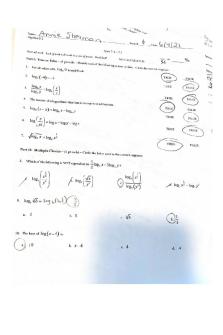Workplace Documents - reference PDF

| Title | Workplace Documents - reference |
|---|---|
| Course | Purposive communication |
| Institution | University of Baguio |
| Pages | 3 |
| File Size | 109.6 KB |
| File Type | |
| Total Downloads | 74 |
| Total Views | 153 |
Summary
reference...
Description
WORKP WORKPLACE LACE DO DOCUMENT CUMENT CUMENTS S
A workplace document is any document that provides steps or gives instructions to carry out tasks that contains technical details. All workplaces use documents to record their business activities.
Some documents need to be completed as part of government acts or regulations, while others are developed to ensure the efficient delivery of services and products to customers.
It is important to know which workplace documents, records and forms you will be expected to complete as part of your job.
There are many different types of workplace documents. Some examples are:
Messages
Memorandum
Business Letters
Minutes from meetings
Agenda
Annual reports
Presentations
Diagrams
Messages, memorandum, minutes and agenda are usually workplace documents that are prepared for internal use. That is, these documents are only used and read by people inside your organization. MESSAGES
Messages come in all sorts of formats. It can be a simple phone message to an email or a short message left for a work colleague.
Whatever the format, it is important to be sure that people’s names are spelled correctly, that phone numbers or other figures are written down correctly.
It is also important to mark on the “message” the time and date as well as who is leaving the message.
Above all, it is vital that you use clear and neat handwriting.
MEMORANDUM
Memorandum or memo is a workplace document that sends information to people in your organization about a work-related topic.
Most messages of this type are sent by email, but in some instances a hard copy of a memorandum is distributed to staff members.
GUIDELINES IN WRITING A MEMORANDUM 1.
Choose a representative phrase that immediately tells the reader what the memo will be about.
2.
Use plain paper (not stationery) with one-inch margins around the page.
3.
Use a professional font and black color.
4.
Begin all the lines of the memo at the left margin, except the MEMO line which can be centered.
5.
Use single-spaced, with two spaces between paragraphs in the body of the memo.
6.
If your memo is more than 1 page long, use a subsequent page header that includes who the Memo is addressed to, the page number, and the
date. 7.
Sign the Memo next to the FROM line, using initials, first name, or complete name.
8.
Don’t add a greeting between the memo heading and body.
9.
Use declarative verbs, and simple sentence structure.
10.
Be specific and detailed without including unnecessary (i.e. time-wasting or confusing) information and without insulting reader’s intelligence.
11.
Use a more informal tone. Remember, however, that what counts as “formal” or “informal” is defined in terms of each organization’s culture.
12.
Pay attention to the intended audience and context. Be guided with the template below....
Similar Free PDFs

Workplace Documents - reference
- 3 Pages

Waterstones - DOCUMENTS
- 3 Pages

Documents Martinistes
- 75 Pages

Physics Documents
- 24 Pages

Contemporary Workplace
- 4 Pages

Les documents
- 3 Pages

Disclosure documents
- 7 Pages

Workplace Reflection
- 10 Pages

Workplace Behaviors Worksheet
- 5 Pages

Workplace Application #2
- 1 Pages

Motivation Theory in Workplace
- 2 Pages

Workplace Essay Plans
- 26 Pages

Workplace Ergonomics Report
- 14 Pages

OBM182 Meeting Documents
- 11 Pages

Olivia Jones documents
- 3 Pages
Popular Institutions
- Tinajero National High School - Annex
- Politeknik Caltex Riau
- Yokohama City University
- SGT University
- University of Al-Qadisiyah
- Divine Word College of Vigan
- Techniek College Rotterdam
- Universidade de Santiago
- Universiti Teknologi MARA Cawangan Johor Kampus Pasir Gudang
- Poltekkes Kemenkes Yogyakarta
- Baguio City National High School
- Colegio san marcos
- preparatoria uno
- Centro de Bachillerato Tecnológico Industrial y de Servicios No. 107
- Dalian Maritime University
- Quang Trung Secondary School
- Colegio Tecnológico en Informática
- Corporación Regional de Educación Superior
- Grupo CEDVA
- Dar Al Uloom University
- Centro de Estudios Preuniversitarios de la Universidad Nacional de Ingeniería
- 上智大学
- Aakash International School, Nuna Majara
- San Felipe Neri Catholic School
- Kang Chiao International School - New Taipei City
- Misamis Occidental National High School
- Institución Educativa Escuela Normal Juan Ladrilleros
- Kolehiyo ng Pantukan
- Batanes State College
- Instituto Continental
- Sekolah Menengah Kejuruan Kesehatan Kaltara (Tarakan)
- Colegio de La Inmaculada Concepcion - Cebu
